By Nicolas Rabener, FactorResearch
Factor Investing in the Wild West of Financial Markets
Summary:
- Cryptocurrencies have reached a market capitalisation of > $150bn
- Backtesting quantitative strategies is difficult given a limited trading history & universe
- Short-term Momentum works very well, classic factor investing strategies less so
INTRODUCTION
The year 2017 might be regarded as the year where cryptocurrencies became mainstream. Investment funds focused on cryptocurrencies were launched, the CBOE announced Bitcoin futures for the end of the year and some everyday expenses like booking flights at Expedia can be paid in Bitcoins. Institutional investors have been cautious entering the space, but are slowly getting more active given that the market capitalisation of cryptocurrencies reached $150 billion and returns for many cryptocurrencies are up several hundreds of percent year-to-date. Fundamental analysis of cryptocurrencies is challenging as there are limited fundamental data points; however, quantitative trading strategies might be attractive. In this short research note we will analyse the performance of quantitative strategies in the cryptocurrency space.
We need to emphasize that executing strategies in cryptocurrencies is currently difficult given high transaction costs and the inability to short efficiently, so the results from this research note are more theoretical than practical in nature.
METHODOLOGY
We focus on seven cryptocurrencies namely Bitcoin, Ethereum, Ripple, Litecoin, Dash, NEM and Monero that were selected on having at least one year of trading history, which is essential for backtesting. The analysis covers the following strategies: Size, Momentum, Low Volatility, Mean-Reversion and Short-term Momentum. The quantitative strategies are created by constructing long-short portfolios of the top and bottom 30% of the cryptocurrency universe. Portfolios are rebalanced monthly for all strategies, except for Mean-Reversion and Short-term Momentum, where portfolios are created daily and held for a week. The analysis includes 25bps of costs per transaction.
CRYPTOCURRENCY UNIVERSE OVERVIEW
The cryptocurrency universe has reached a market capitalization of more than $150 billion recently, which is mainly due to the significant increase in prices since the start of the year. The chart below shows the current market capitalisations for selected cryptocurrencies, where we can observe that Bitcoin dominates the universe with a market share of approximately 70%.
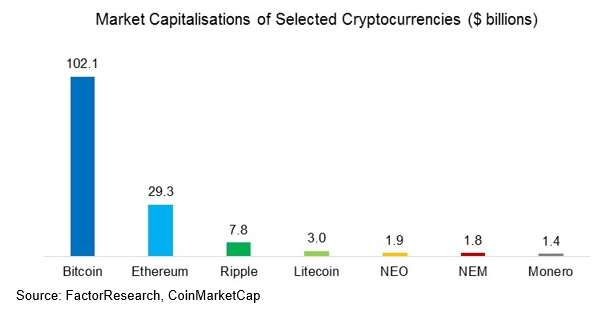
CRYPTOCURRENCY PERFORMANCE
The next chart shows the performance of selected cryptocurrencies, all indexed at a 1,000. We can see a significant amount of volatility over time with most cryptocurrencies experiencing severe drawdowns from 2012 to 2014 and stellar returns thereafter. The two common themes behind the creation of cryptocurrencies are limited supply and anonymity. Supply of new coins is limited in order to avoid the silent inflation of established currencies. The first demand likely originated with black market participants and then Chinese savers trying to export their capital, both valuing the anonymity of cryptocurrencies. Currently demand is fuelled by the greed of retail investors who see significant wealth being generated and can not resist the urge to participate, therefore creating a self-fulfilling prophecy.
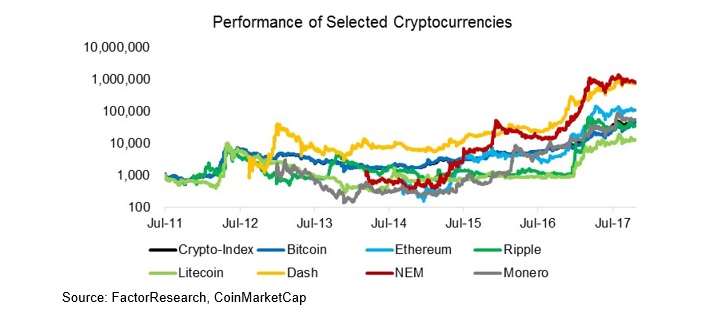
SIZE FACTOR
The first quantitative strategy we test is the Size factor, which is a well-established factor in equity markets. The long portfolio contains cryptocurrencies with small market capitalisations and the short portfolio cryptocurrencies with large market capitalisations. We can observe that the returns were positive overall, but with a significant amount of volatility.
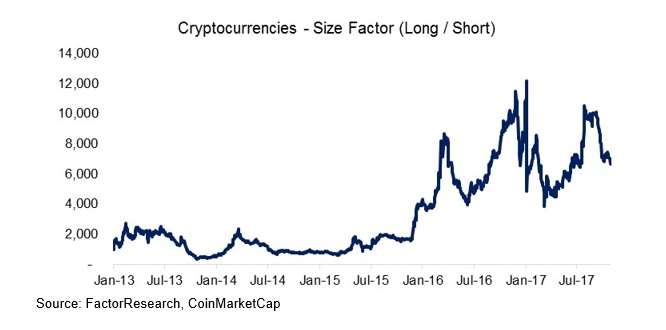
MOMENTUM FACTOR
Next we analyse the Momentum factor, which buys the winning and shorts the losing cryptocurrencies, measured over the last year excluding the last month. We can see that the factor generated highly unattractive results, including two significant drawdowns. The recent crash in January 2017 was due to a short position in Litecoin, which showed the lowest performance over the last year at that point in time, but then almost tripled in two weeks. Quantitative strategies seek to avoid such single stock or currency risks by diversifying across many assets, but the limited number of cryptocurrencies currently available is prohibiting this.
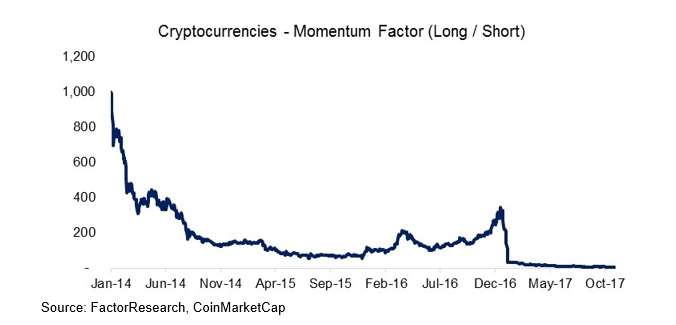
LOW VOLATILITY FACTOR
The Low Volatility factor is created by buying cryptocurrencies with low volatility and shorting cryptocurrencies with high volatility, adjusted for the beta of the cryptocurrencies. The underlying theory is that low risk assets outperform high risk assets on a risk-adjusted basis due to behavioural biases of market participants. We can observe in the chart below that this strategy does not work very well in the cryptocurrency space.
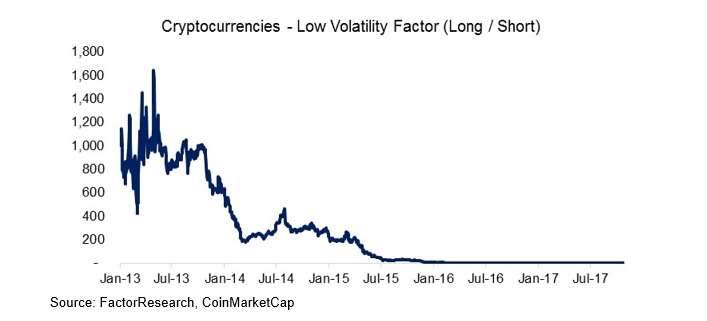
MEAN-REVERSION
Mean-Reversion is a short-term trading strategy that is created by buying last week’s losers and shorting last week’s winners. The underlying theory is that investors frequently tend to overreact and traders get compensated by providing liquidity in these situations. Mean-Reversion therefore benefits from high volatility as more mistakes are made by investors, but we can see in the chart below that this strategy does not perform well, despite the high volatility of cryptocurrencies, which is perplexing.
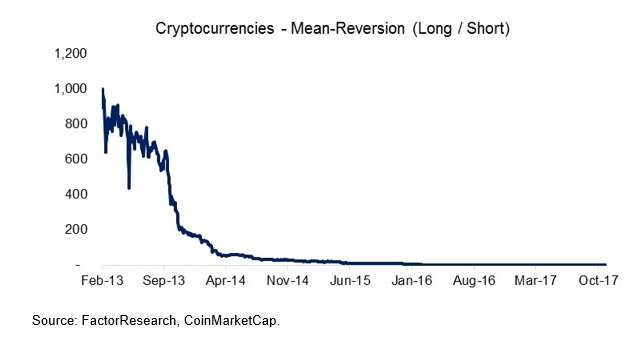
SHORT-TERM MOMENTUM
Given that the returns for Mean-Reversion were consistently negative, the opposite strategy might be attractive. We define Short-term Momentum as buying last week’s winners and shorting last week’s losers. We can observe that this strategy would have generated strong returns over the last few years. However, a word of caution – the S&P 500 showed highly attractive returns for a Short-term Momentum strategy for decades until the early 1990s, but very negative returns thereafter. Although Short-term Momentum might seem attractive in the cryptocurrency space currently, Mean-Reversion dominates in most financial markets on a short-term horizon.
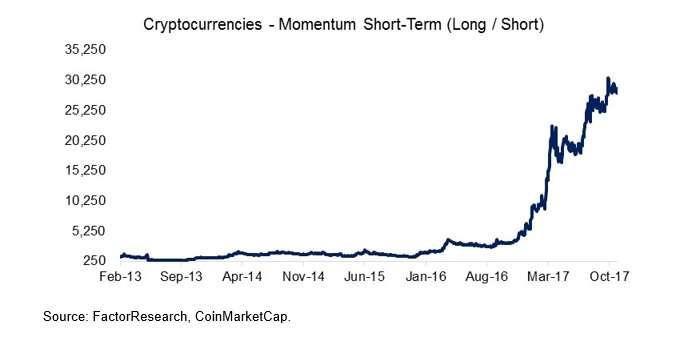
FURTHER THOUGHTS
This short research note highlights the performance of quantitative strategies in the cryptocurrency space. The results show that classic factor strategies have not performed well, except for Short-Term Momentum. A few years ago it would have been easy to dismiss cryptocurrencies, but this is getting difficult as more participants join each day. It’s questionable how many cryptocurrencies are needed and there will likely be a few boom & bust cycles ahead; however, a new asset class was borne, which is unlikely to go away.




